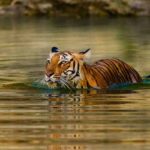10 Places To Visit In Ranthambore With its distinct class and beauty, Ranthambore National Park holds an important role in India’s tourism market. Ranthambore National Park, however, is not one of India’s biggest national parks, but it is certainly the most popular. The Ranthambore forest, situated in the vicinity of the Aravali hills and Vindhya plateau, stretches over an area of 1334 sq km with the area as a national park of 392 sq km. The Ranthambore tiger reserve is very famous among wildlife lovers for its daytime tigers, which means that tourists can easily spot a tiger during their day safari visit, highly revered for the natural habitat to the significant number of Royal Bengal tigers.
The name of the National Park comes from the famous Ranthambore Fort, which is located within the park. The park is situated in the Sawai Madhopur district of Rajasthan and is approximately 11 km from Sawai Madhopur railway station. Sawai Madhopur is approximately 130 km from Rajasthan ‘s capital, Jaipur. The Ranthambore forest was under the Kingdom of Jaipur prior to India’s independence and was the hunting place for the Maharajah and other royal members of the Kingdom of Jaipur. The forest was integrated into the tiger project in 1973 and proclaimed in 1980 as a national park.
Today, for the Ranthambore National Park safari, Ranthambhore National Park is a popular tourist destination. Thousands of tiger lovers from around the world visit here daily during the safari season due to many of the famous tigers living in this forest park. The tigress Machli was the most celebrated tiger in the world, among many famous tigers. In August 2016, however, she died last year, but left several legends of her youth days. Many wildlife movies, films and TV shows influenced her prodigy of courage and strength. Seeing these deadly wild predators at a short distance in their natural wild habitat is really an adrenaline-pumping adventure to enjoy for a lifetime.
Not only does the Ranthambhore National Park boast of its populous tiger reserve, but also the heritage sites that include the mighty Ranthambore Fort, Jogi Mahal, the ancient temple and the Rajbagh ruins that are the Ranthamborean rulers’ reminders of glory and grandeur. The scenery of this forest, consisting of deciduous forest, small hills, valleys and lush greenery, is enriched by many picturesque lakes, such as Padam Talao, Malik Talao, Raj Bagh Talao and others. The park is surrounded on both sides by the Chambal River and the Banas River, enhancing the wild environment of the Ranthambhore forest. Without a doubt, if you actually love nature and wildlife, the tour to this National Park of Rajasthan would be the best holiday for you. The entire experience of seeing magnificent tigers wandering freely in the park, a mesmerising variety of ultimate animal and bird species and captivating greenery will captivate your mind and you will be thanking yourself for embarking on this wildlife journey.
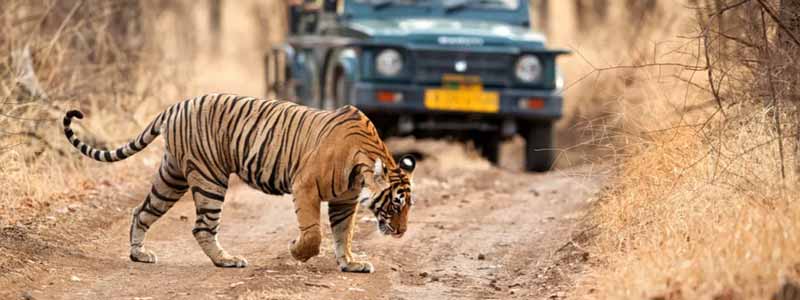
Ranthambore Tiger Reserve – Ideal For Animal Lovers
Online safari booking for Ranthambore Tiger Reserve Here you can use the online booking service offered here to make your online booking for Ranthambore Tiger Reserve in both Jeep and Canter safari as per your preference. All of the Ranthambore Safari booking control for Jeeps and Canters is completely administered and operated by the Ranthambore Forest Authority. The tiger reserve area of Ranthambore is divided into 10 safari zones or roads, and all areas are arranged for a safari tour. For all the zones of the Reserve, the Ranthambore Tiger Safari booking service is open, but the safari zones are allocated by the forest authority to the Jeeps and Canters using a computerised allocation system just before entering the Ranthambore Tiger Reserve.
If you make your reservation 365 days in advance, you will then be assigned randomly to the zone of your choosing, However, if you do not book 365 days in advance and visitors are also permitted to change the allocated route, there is no provision for making your own choice of safari zones. Visitors may request a change in the safari zone for their safari Jeep after paying the necessary additional fees, but the decision to change the Ranthambore Forest safari zone depends solely on the forest authority.
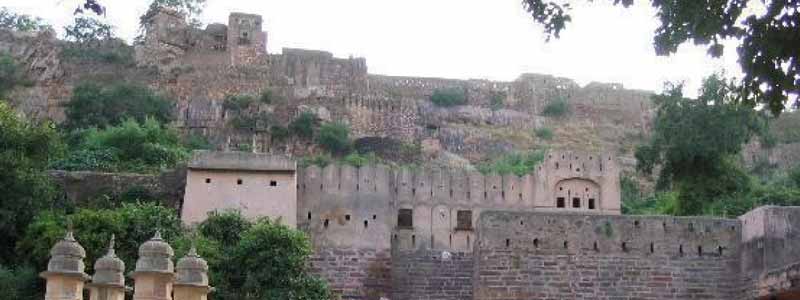
Ranthambore Fort – Dig Into The History
Deep within Ranthambore National Park, Ranthambore Fort is nestled. The National Park consists of an area that used to be the hunting grounds of Jaipur ‘s former kings. Standing atop a 700 ft hill, under “Hill Forts of Rajasthan,” the fort is listed as a UNESCO World Heritage Site. Among Ranthambore’s most famous attractions, the imposing fort has been central to the history of the state of Rajasthan.
It is assumed that Ranthambore Fort was founded by the Chauhan’s in the 10th century due to safety measures. The Delhi Sultanate finally seized the fort in the 13th century. Visitors will find elements of Rajasthani architecture here: towering gates, domes, paths of stone, thick walls, water reservoirs, and temples. Via one of the seven gates, namely Ganesh Pol, Andheri Pol, Navlakha Pol, Hathi Pol, Satpol, Suraj Pol and Delhi Pol, visitors can enter. Other attractions not to be missed are Mahadeo Chhatri, Toran Dwar, and Sametonki Haveli. Among devotees, the on-site Ganesha Temple is well known and attracts crowds in large numbers.
This is a worthwhile visit because of the panoramic views of the National Park itself. Free for everyone, the fort is open from 6:00 AM to 6:00 PM. This is where tourists can try to catch the sunset. From April to October, Ranthambore Fort is the best time to visit.
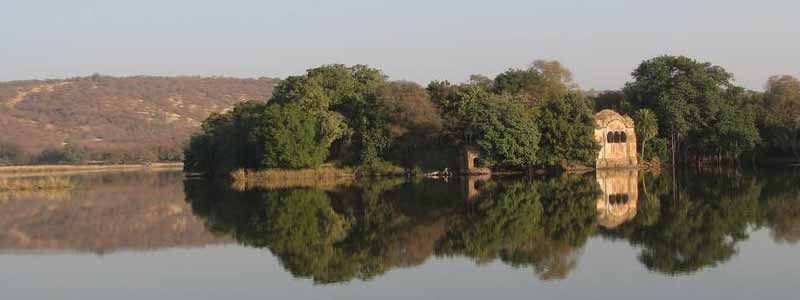
Surwal Lake – Resort To A Tranquil Place
Surwal Lake, home to almost 300 species of birds, is a seasonal lake. Surwal Lake, a peaceful sojourn amid the thick forests of Ranthambore, is about 10 km from Sawai Madhopur Township. The Lake is not located within the Ranthambore National Park and can be reached free of charge even if the national park is not open and there are not many visiting and bird watching restrictions, as in the national park.
With plenty of water and lush vegetation surrounding it, the lake is spectacular in the winter months between October and March. This is the time when, both within and outside the Ranthambore National Park, many migratory birds migrate into this serene ecosystem and the other water bodies.
Professional bird watchers, wildlife photographers, and nature lovers spot the various types of birds on a field day. During these months, in the early mornings, particularly before daybreak, birds can be seen hunting for food and building nests. With their binoculars and sharp cameras, birds can come out and identify at least 100 bird species in one morning. It makes it an experience to remember the chirping of the birds accompanied by their calls and song.
Graylag geese, painted storks, bulbuls, mynas, spoonbills are some of the birds visiting the lake, quails, flamingoes, and Saras cranes, bee-eaters and Kingfishers. Also present are larks, pipits, woodpeckers, Prinias, cormorants, egrets, herons, bitterns, darters, crows, snipes and sandpipers. Some of the predatory birds, which are permanent residents of the park and also frequent the lake for prey, are falcons, eagles and vultures.
Because of the extreme heat in Rajasthan during the summers, this shallow lake dries up and birds migrate again before the next season. So, in the winter months between November and March, schedule your trip to Ranthambore and Surwal Lake to relax in the pristine surroundings of Surwal Lake and take home some lovely memories and images of the wild.
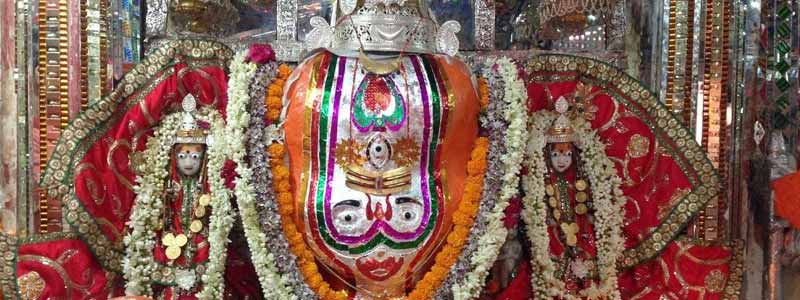
Trinetra Ganesh Temple – Pray For Everyone
Ranthambore Ganesh Temple, situated at Ranthambore Fort, is a very old temple. For devotees and tourists, it is a very heart interaction spot. Ranthambore Ganesh Temple, dedicated to Lord Ganesha, and approximately 12 km from Sawai Madhopur. It is said that there was a battle between King Hammir and Alauddin Khilji in 1299 AD. They filled godowns with food and all the necessary stuff in Ranthambhore Fort, where the King resides, during the time of war. The stock of go-downs was over as the war lasted for many years. One night, when King Hammir was sleeping, who was a great devotee of God Ganesh, he dreamed that Lord Ganesh would come to him and tell that by tomorrow morning all the problems and failures would be over. An idol of Lord Ganesh with three eyes (Trinetra) in the morning, embossed from one of the walls of the fort. The War was over as a miracle and the godowns were finished. King Hammer constructed Lord Ganesh’s temple in 1300 AD and installed Riddhi Siddhi, his wife and two sons, Shub Labh, along with Ganesh’s idol. His mushak (mouse) vehicle is also located there.
A special place in Ranthambore is held by Ganesh Chaturthi and is celebrated to commemorate the origin of Lord Ganesh, who is said to have been born on this day. Thousands of devotees visit the temple on this day. Songs and ‘bhajans‘ are there praising Lord Ganesha. One of the most eminent Ganesha temples in Rajasthan is the Ganesha temple at the Fort of Ranthambore.
Padam Lake – Spend Some Quiet Time
The Padam Talao is situated within Ranthambore National Park, a wide and beautiful lake. It gets its name from the blooming lotus flowers in the pool.
A favourite watering hole of the Ranthambore animals is the Padam Talao. In the early morning and late evening, lions, leopards, deer, monkeys and peacocks can be seen drinking on the edge of the lakes. Machans or huts on observation posts near Padam Talao are a fantastic platform from which tourists can see the animals in their natural habits. One of Ranthambore ‘s legendary tigers, Genghis, was popular for hunting deer that came to drink on the lakeside.
On the banks of Padam Talao, the hunting lodge named Jogi Mahal is located. A magnificent one is the view from the Jogi Mahal. Established by the royal families of Jaipur, Jogi Mahal served as a hunting residence for various generations of Jaipur Maharaja. After the decline of Jaipur ‘s ruling authorities, this Mahal is converted into a guest house that during their visit to Ranthambore offers tourists a pleasant stay.
The banyan tree, which is considered the second largest banyan tree in India, can also be visited by tourists. For photography and shooting, the lake offers wonderful views of wildlife.
Kachida Valley – Lookout For Panthers
Kacheeda Valley, also known as Kachida Valley, is situated on the outskirts of Ranthambore National Park and is a wonderful tourist spot. This national park, including the tiger and leopard, is the home of big cats. In this valley, these great cats are found in the largest number, but they have their own territories. In Kacheeda Valley, other animals such as the bear, stag, mongoose, etc. are also found.
Jogi Mahal – The Royal Side Of Ranthambore
Jogi Mahal is a beautiful guest house in the Sawai Madhopur district of Rajasthan state, situated in Ranthambore National Park. Jogi Mahal is an important attraction in Ranthambore National Park, situated on the banks of Padmala Talab, in front of Ranthambore Fort. Where visitors can see numerous animal species and birds roaming while drinking water in Ranthambore Park.
Jogi Mahal was designed by Jaipur’s royal family. And it was used for hunting and lodging for several generations of the royal family. All modern facilities for tourists are offered by this guest house. From the Jogi Mahal, visitors can enjoy a relaxing view of Padam Talav.
Jogi Mahal, located in the centre of Ranthambore Park, is a lovely and interesting attraction. The second-largest banyan tree in India is an enormous banyan tree near the Jogi Mahal. Those who want to enjoy Jogi Mahal can go to Anantapur from here to Lahpurand, to Nal Valley, and to Bakul.
This very beautiful location is an important draw for lovers of nature and animals.
Raj Bagh Ruins – Get Back To The Ancient Era
For an enormous number of the herbivorous inhabitants of Ranthambore, the Rajbagh Talao is a critical source of sustenance and water. The important attractions of the place are the creatures that seem to rush to its waters reliably and also observe the large population of creatures and winged creatures promoting it. The lake is somewhat protected by boggy trees. Nearby, Sambar, Chital, Nilgai and Blackbuck are seen drinking, peacocks, and wild hogs. In the Rajbagh Talao, tigers are frequently observed stalking the deer that come to drink and maintain.
Situated along the banks of the lake, the Rajbagh ruins add to its fascinating climate. The remains of these buildings include separate curved rooms and toilets, unfinished standing dividers and arches. In Ranthambore National Park, the great tigers of Ranthambore can be seen unwinding in the shade of these structures.
Malik Talao – Calm Your Senses
The smallest lake inside the premises is Malik Talao. Located within zones 3 and 4, it is a refuge for bird-watchers as the serene water body is frequented by many species. There are also Indian marsh crocodiles, kingfishers, storks, egrets, herons, ibis, cranes, and many more birds and reptiles. The lake is surrounded by many banyan trees, enhancing its appearance. If you want to spot tigers, schedule your summer trip to Ranthambore National Park, as that’s the best time to visit it.
For photographers, it is a paradise too, as the views of the lake and the surroundings are simply breathtaking. You might even see some of the animals in action if it is your lucky day. Though wild boars and peacocks can be seen strolling on their beaches, it is possible to spot mugger crocodiles lazing around in the sun. As many small fish are found here, tourists can also enjoy fishing. From 6:00 AM until 6:00 PM, the lake is open to tourists.
Rajiv Gandhi Regional Museum Of Natural History – Visit It
Rajiv Gandhi Regional Museum of Natural History, the historic town of Rajasthan sawai Madhopur, renowned for an important Tiger site project in Ranthambhore. It is planned to be the fourth Western Region Regional Museum of Natural History in Sawai Madhopur. The museum is located in Ramsinghpura Village, Sawai Madhopur, Rajasthan , India. It is dispersed over an area covering 7.2 acres of land. Ramsinghpura Village is about 9 km from Sawai Madhopur. In addition to serving as a resource centre for the public in general and children / students in particular, this museum was built to highlight the natural heritage, plants and animals of the west region of the world. The combination of the RG RMNH and the Ranthambhore National Park and cultural heritage centres such as Shilpgram and Ranthambhore Fort has made Sawai Madhopur one of the country ‘s finest heritage attractions.
“The Ranthambore museum opens with gallery 1 on” Rajasthan ‘s Biodiversity “or” Rajasthan’s Forests and Wildlife. With respect to its plants, livestock, wildlife and forests, it portrays the richness of Rajasthan. In addition to significant dioramas on various subjects, the gallery has digitally mounted panels, interactive displays and photographic representations of wildlife, illustrating the human interface with nature in its efforts to protect nature and natural resources. It also includes a diorama of the Bishnoi culture, famous for saving trees by sacrificing their lives. In the future, other galleries will include Gallery 2: Biomes & Ecosystems. Gallery 3: Wilderness. Ecology (Nature’s Network) & conservation: Gallery 4. Gallery 5: Life’s Beginning and Evolution. The auditorium, library and khojkaksh (discovery room) are other properties. Timing for tourists-10:00 AM to 5:00 PM. On Mondays and national holidays, the museum remains closed.

